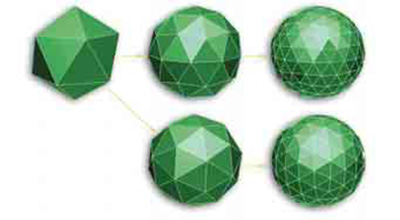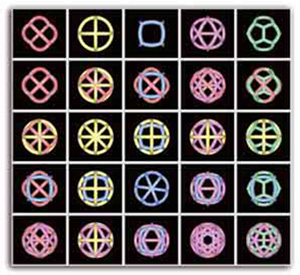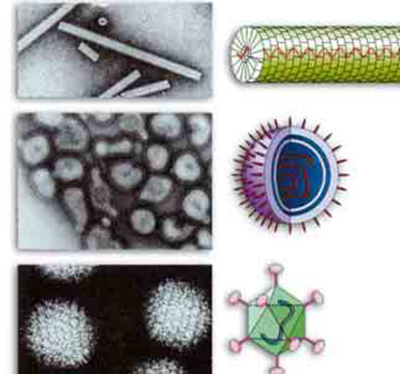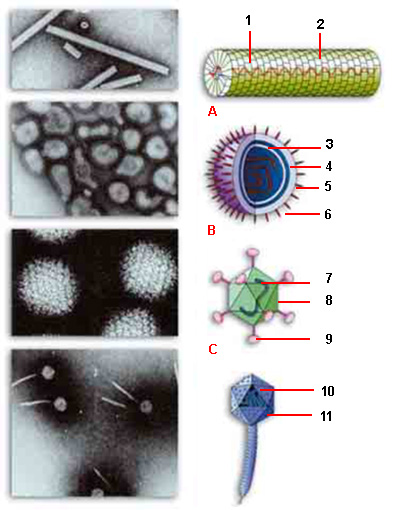Viruses
The human body's worst enemy, a virus uses any human cell as a shelter for itself, multiplies there, and sometimes leads to the death of the individual.
A virus consists of a protein sheath and inside the sheath, genetic codes, DNA and/or RNA, that containing the information to replicate itself. It has no functioning organelles exhibiting signs of life on their own, no way to produce energy or synthesize proteins. It therefore relies on the existence of a living cell that can perform these vital functions for it. That is why a virus can remain unchanged, in a state of suspended animation, for millions of years. No change or impairment takes place in its structure during that very long time. But upon encountering an organism, it immediately comes to life and goes into action. It now resembles a conscious entity, seemingly capable of planning, developing strategies and using intelligence. The sole reason for this extraordinary change is that Allah has given it life and inspired in it the need to take action. No other force, knowledge or technological mechanism can bring about this extraordinary conscious behavior.
 |
1. DNA |
he virus infecting the bacteria, the bacteriophage, can be seen on the right. |
A virus can remain in an inanimate state for a long time. The only things it needs to awaken are the warmth and moisture of a cell which it can enter and infect. Once it has entered a cell, it can sometimes reproduce itself 100 times in an hour and can sometimes alter its genetic structure so much as to kill 20 million human beings in a year. Viruses, despite wielding such powerful and lethal effects, are so small that 1018 of them (10 followed by 18 zeros) would only just fill a ping-pong ball. If one virus had been placed inside a ping-pong ball every second since the beginning of the universe, the ball would still only be half full today. Not all viruses are the same size, of course. Some are thousands of times larger than those just mentioned, but it would still take 30 million years for them to fill a ping-pong ball. Others are up to 80 times smaller, and would be unable to fill a ping-pong ball in 2 trillion years. of them (10 followed by 18 zeros) would only just fill a ping-pong ball. If one virus had been placed inside a ping-pong ball every second since the beginning of the universe, the ball would still only be half full today.
Not all viruses are the same size, of course. Some are thousands of times larger than those just mentioned, but it would still take 30 million years for them to fill a ping-pong ball. Others are up to 80 times smaller, and would be unable to fill a ping-pong ball in 2 trillion years. 64
When you examine the structure of viruses close up, you can see that they possess a perfect structure. The molecules making up the virus sheath give it a literally gemlike appearance. Each virus with its own unique geometrical shape gives rise to amazing patterns. Just as in all structures in nature, there are various rules and measurements in its construction, determined through so-called cubic symmetry. Various scientists spent years of research to solve the laws of these architectural structures. The viral forms that emerge as a result of these geometrical laws are icosahedrons. In a typical example, there will be 20 surfaces, each consisting of an equilateral triangle.
Different viruses have multi-faceted external shells by using different geometrical shapes, such as pentagons. Other viruses have tubular or cylindrical shapes, and to them, the laws of spiral symmetry apply.
It has taken science years to investigate viruses using x-ray analysis and other complex newly discovered methods. This organism, which affects all of life using its own techniques and leads to mass deaths of various plants and animals, basically consists of just a cell membrane and DNA. It was discovered only in the last century, and we have been seeking to unravel its secrets for the last 30 years. Until now, however, countless thousands of people have been subjected to the disease-causing effects of this microorganism. Viruses have used the same methods, acting with the same division of labor, for millions of years, unaware even of the existence of their human hosts. This is a manifestation of Allah's infinite knowledge.
How Does a Virus Install Itself in Human Beings?
 |
It would still take even the largest viruses 30 million years to fill a ping-pong ball (at the rate of 1 virus every second since the beginning of the universe). |
A living virus can enter a cell and turn its inner workings to its own purposes. Before entering a cell, the virus determines whether the cell is suitable for it. If it is, the virus empties out itself into that cell. The cell generally detects nothing odd about this new DNA entering in and therefore does not recognize it as foreign and is therefore unable to declare war on this substance that it has failed to identify. The cell transports the virus's DNA to where the DNA should be in the cell, in other words directly toward the nucleus, where the virus combines with the cell's own DNA.
Following this, the cell begins to produce new viruses, believing itself to be manufacturing new proteins.
It is exceedingly difficult to distinguish this "new" DNA molecule concealed inside the cell, akin to looking for half a line piece of text in a 20-volume set of encyclopedias. For that reason, the cell keeps producing the virus without stopping.
The cell is an organism that performs delicate processes within a delicate balance. A different DNA included within that delicate structure would impair that entire order. It will continue to discharge its responsibilities to the letter, but the result will have a devastating impact on the entire body. If the importance of the impairments is only minor then the cells with the virus inside them add the virus's nucleus element to their own chromosomes and begin dividing in a different manner. This is uncontrolled cell multiplication, and the cells in question soon turn into cancer cells.65 This irregularity may sometimes lead to a person's death. Herpes viruses may settle in a human nerve cell and wait there quietly, giving no indication of their presence for days, or even years. These viruses wait for a moment when the immune system is weakened. When the body is unable to resist it, the viruses will go into action and migrate to the surface, where they initiate their activities inside skin cells.
 |
The structures known as icosahedrons possessed by viruses consist of 20 surfaces made up of equilateral triangles. |
The really surprising thing is the way that a structure such as the cell, which allows no foreign substance to enter it, can be used by the virus in this manner. The virus does not just settle in to make a home for itself, but also uses the cell's own mechanisms to reproduce. The seemingly conscious behavior exhibited here is still not understood by scientists.
Under the effect of the virus that has entered it, the cell is doomed, though it will expend the last of its energy until it dies and breaks down. The virus, which has now reproduced and grown much more numerous, spreads out to other cells.
This invasion takes place at breathtaking speed. Some viral epidemics have eliminated whole communities in a matter of days. One flu epidemic in 1918, for instance, killed 20 million people most of who died just a few hours after their symptoms first appeared. 66
We now need to think a little about this conscious event caused by a single virus. From where does the living thing we refer to as a virus, consisting of just an outer casing and DNA, receive instruction as to how and when to enter the cell? How is it able to come alive and reproduce after remaining dormant, being as inanimate as a stone? What allows it to survive the long years of dormancy? Moreover, how does a virus possess the knowledge of how to occupy the whole body by entering a cell in a human being's body? Where is this information maintained, and how does the virus make use of it? No virus can possess any intelligence. Allah created it to perform all these actions flawlessly. In one verse it is revealed:
In the alternation of night and day and what Allah has created in the heavens and the Earth, there are signs for people who guard against evil. (Surah Yunus, 6)
 |  |
Different viruses have multi-surfaced and symmetrical outer casings using various geometrical shapes. This symmetry and artistry in a single microorganism is one of the examples of Allah's sublime Creation. | |
Viruses Come in Many Forms
 | |
A. Tobacco Mosaic Virus 1. RNA Body 3. RNA Body | 5. Phospholipids Membrane 7. DNA Body 10. DNA Body |
All viruses have various forms and features depending on their spheres of activity. The way these microorganisms assume such forms is without doubt most thought-provoking. | |
Viruses possess a genetic structure, but have no capacity to make that genetic information work for themselves. On their own, they lack this essential property of life. This organism's genetic structure cannot even be regarded living in every sense of the word, yet it does however display an unbelievable variety. A virus possesses a genome of a rather large number of "letters." Another more interesting feature is that the genome of every virus in a matchless one-off.
Viruses possess various sequences of letters depending on their length. The hepatitis B virus, for example, consists of 3.200 nucleotides, or letters. The HIV virus has 10.000 nucleotides. Larger viruses such as the herpes viruses that cause cold sores, have around 100,000 nucleotides. Thanks to the information concealed in their DNA, the only organs these organisms possess, they can reproduce and survive by entering other cells. All these properties have been squeezed into their DNA.
Thanks to their superior abilities, viruses can also change their genetic qualities in a very short time. The very same disease can exhibit different symptoms and varying degrees of virulence, thanks to viruses' ability to change their genetic makeup. No vaccinations can be effective against such diseases because of these sudden changes.
The virus can enter a cell in its new form without its presence triggering the immune response that responded to its earlier form. Under normal conditions, vaccines—-the only precaution against viruses—stimulate the body to recognize viral strains that may infect it later, but are ineffective against a virus that has mutated itself. When a killed virus is introduced through vaccination, the immune system perceives it as hostile and produces antibodies to destroy it. However, vaccines are unable to recognize a new virus that produces the same disease but which has altered its genes. Indeed, a flu vaccine becomes obsolete the following year, because the influenza virus assumes a new form every year. This also applies to the HIV virus that leads to AIDS. However, the HIV virus mutates so fast that the antiviral medications eventually lose their effectiveness.
 |
1. Radioactive DNA |
Infection of a bacterium by a bacteriophage and the formation of new viruses |
It is impossible not to see the superior and intelligent ability of the virus here. The virus's speed of reproduction and changing its own form is so rapid as to far exceed those of human technology. An average virus can produce 10.000 new particles a day. If you have one viral particle on Monday, you will have 10.000 on Tuesday and soon 10.000 times 10.000, and then 10.000 times 10.000 times 10.000—1.000 billion viral particles.
When the HIV virus, for example, enters the body, the immune system destroys more than half the invading particles by within five days. Yet just as many new particles emerge during that same time. When at least one is recognized by the defense system, the others will mutate into a different form, thus resisting the attacks and becoming the first generation of the new HIV population.
From the perspective of the theory of evolution, viruses pose yet another unanswered question. The virus occupies an imaginary place on the evolutionary tree. When and how did this organism emerge? There are no fossil remains. All the scenarios of evolution have is conjecture. Heading the list of questions that give evolutionists trouble the virus's complex structure. In fact, evolutionists often classify viruses as primitive single-celled organisms like bacteria, except bacteria and viruses possess very different structures. A great many species of bacteria possess spherical chromosomes that float freely within the cell, whereas the rod-shaped chromosomes of viruses (and of human beings) are protected in the nucleus. In these terms, viruses—especially ones of the pox group—are more similar to the eukaryotes than to the prokaryotes, of which bacteria are members. In addition, the DNA and RNA packets constituting the virus's structure are totally different from those of bacteria.
What power that gives rise to such differentiation and gives viruses their ability?
Those who seek to answer "Evolution!" will always be facing inconsistencies. They may claim that the difference stems from differently functioning evolutionary mechanisms and will continue to advance new theories. Though aware of this flawless Creation, they will continue to deny it. And the more numerous such questions will become, forcing Darwinists to continue desperately searching for new lies and coming up with new theories. Like all evolutionists before them, those who make these new claims will also waste their lives without finding any solution. And like all evolutionist claims ever been made, their claims will remain groundless and unsupported. A few will conclude that the "laws" that have been around since Darwin's era have achieved no explanations, and that it is illogical to fly in the face of the facts. But others will have no compunction about supporting a theory built on falsehoods.
There is absolutely no doubt that a virus, which manages to enter just one out of a human being's 100 trillion cells using incomparable methods, and which can cause the death of the individual and even of whole communities, despite being so miniscule in size, is a great miracle of Allah. They have been created so we may understand see the omniscience of Allah. Viruses have been brought into being so that we may witness how defenseless we are in the face of particles too small to be seen with the naked eye. Like all the works on Earth, this organism proclaims the might of its Creator.
That is the truth, whether people accept it or not. Allah reveals on this subject that:
[Hud said,] "I have put my trust in Allah, my Lord and your Lord. There is no creature He does not hold by the forelock. My Lord is on a Straight Path." (Surah Hud, 56)
 |
A. Hepatitis B virus C. The HIV renews itself so quickly that the effect of a vaccine developed against it lasts less than a day. |
Footnotes
64- Guy Murchie, The Seven Mysteries of Life, Houghton Mifflin Company, Boston, 1978, sf. 159
65- Büyük Larousse Sözlük ve Ansiklopedisi, Cilt 23, Milliyet, İstanbul, 1986, sf. 12222
66- W.G.L., N.B. and R.G.W, What Accounts for Virulence?, Scientific American, Ocak 1999, sf. 64
